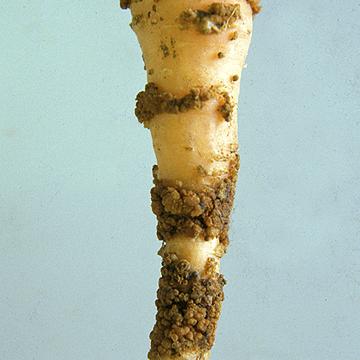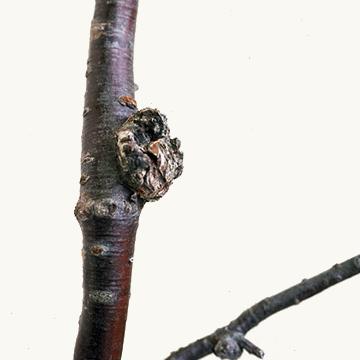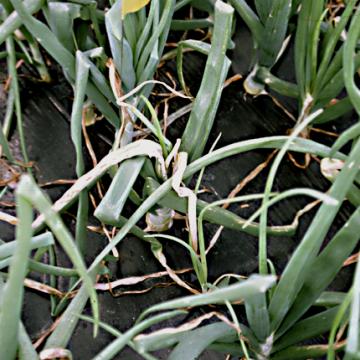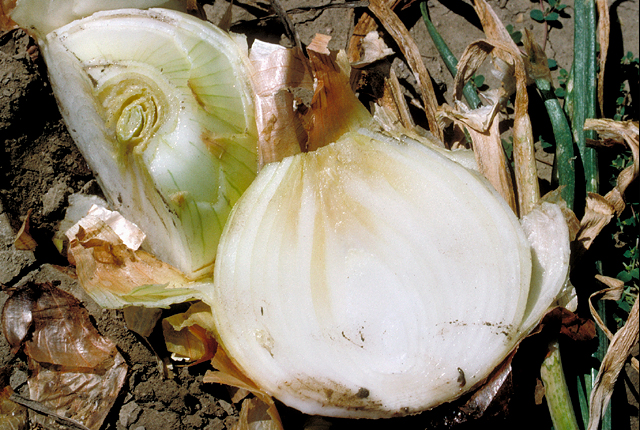DISEASE: Bacterial gall
HOST: Carrot
Root with many galls of different sizes.

Bacterial gall | Carrot
DISEASE: Bacterial gall
HOST: Carrot (Daucus carota)
PATHOGEN: Rhizobacter dauci
SOURCE: H. Kuwata
DISEASE: Bacterial gall
HOST: Carrot
Galls caused from inoculation of injured roots (left two) and uninjured roots (center two). Uninjured, noninoculated root (right).

Bacterial gall | Carrot
DISEASE: Bacterial gall
HOST: Carrot (Daucus carota)
PATHOGEN: Rhizobacter dauci
SOURCE: M. Goto
DISEASE: Bacterial gall
HOST: Cherry
Small gall on twig.

Bacterial gall | Cherry
DISEASE: Bacterial gall
HOST: Cherry (Prunus avium)
PATHOGEN: Pseudomonas syringae pv. cerasicola
SOURCE: H. Kamiunten, M. Goto
DISEASE: Bacterial gall
HOST: Wisteria (Japanese wisteria)
Multiple galls on trunk.

Bacterial gall | Wisteria (Japanese wisteria)
DISEASE: Bacterial gall
HOST: Wisteria (Japanese wisteria) (Wisteria floribunda)
PATHOGEN: Pantoea agglomerans pv. millettiae
PATHOGEN SYNONYM: Erwinia herbicola pv. millettiae
SOURCE: M. Goto
DISEASE: Bacterial gall
HOST: Wisteria (Japanese wisteria)
Gall on branch.

Bacterial gall | Wisteria (Japanese wisteria)
DISEASE: Bacterial gall
HOST: Wisteria (Japanese wisteria) (Wisteria floribunda)
PATHOGEN: Pantoea agglomerans pv. millettiae
PATHOGEN SYNONYM: Erwinia herbicola pv. millettiae
SOURCE: M. Goto
DISEASE: Bacterial pocket
HOST: Beet
Sugar beets with many small tubercles at infection sites.
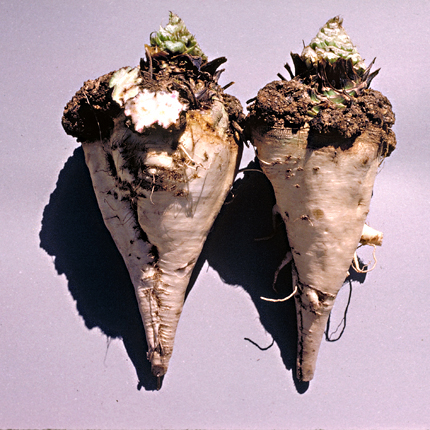
Bacterial pocket | Beet
DISEASE: Bacterial pocket
HOST: Beet (Beta vulgaris)
PATHOGEN: Xanthomonas axonopodis pv. betlicola
PATHOGEN SYNONYM: Xanthomonas campestris pv. betlicola
SOURCE: C. Schneider
DISEASE: Center rot
HOST: Onion
Early symptoms of disease are necrotic, bleached areas on young leaves that typically wilt.

Center rot | Onion
DISEASE: Center rot
HOST: Onion (Allium cepa)
PATHOGEN: Pantoea ananatis
SOURCE: R. Gitaitis
DISEASE: Center rot
HOST: Onion
Advanced stage of center rot. The bacterium has moved down from leaves into the bulb.

Center rot | Onion
DISEASE: Center rot
HOST: Onion (Allium cepa)
PATHOGEN: Pantoea ananatis
SOURCE: H. Schwartz


